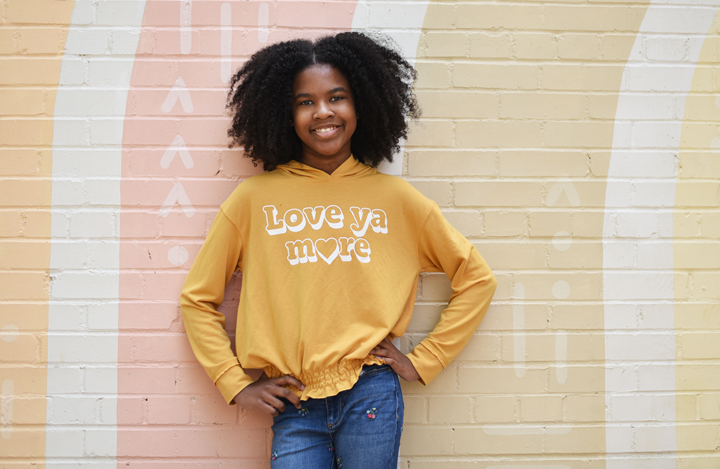Bracing for Scoliosis

What Is Scoliosis Bracing?
Bracing is a common treatment for moderate scoliosis. While most children with scoliosis will never need bracing, orthotics can prevent spine curves from progressing in many patients. A scoliosis brace is like a tight plastic vest that a child can wear daily to keep the spine straight. Some braces are more flexible than others, and some are designed to be exclusively nighttime braces.
Scottish Rite for Children has the expertise your child needs for scoliosis bracing. Our custom in-house orthotics team will ensure the best brace fits, and our comprehensive approach to treatment can help your child adjust to life with a brace.
How Scoliosis Braces Work
If your child is still growing and has a spinal curve between 20 and 40 degrees, a brace for scoliosis may help correct the curvature before it worsens. A scoliosis back brace typically fits the torso from under the armpits to around the hips. The exact shape and length of a brace depend on the severity of the prognosis and the shape of the curves. A scoliosis brace works by applying pressure on the top and the bottom of the spinal curve to help correct it.
Research has found that full-time bracing — around 20 hours a day, for two or more years — in growing children or adolescents is often enough to prevent a need for surgery. Some children may need to wear braces for more or less time daily, but research shows that the longer someone wears a scoliosis brace each day, the more successful it is in stopping curve progression.
Types of Scoliosis Bracing
There are several types of braces used for treating scoliosis. The two most common types of braces are:
- Boston brace: This rigid plastic brace is molded to fit your child’s torso and closes with Velcro straps in the back. It may have cutouts or internal moldings that help the brace apply pressure to the spine’s curve. It is designed to be worn under the clothes.
- Wilmington brace: This brace is like a Boston brace but closes in the front.
Orthopedic specialists may recommend a Charleston bending brace for some children. This nighttime brace bends the spine to one side to correct spinal curves in the lower back. There are also newer, more flexible braces, but research on how well they work is ongoing.
In-House Scoliosis Brace Production
Scottish Rite makes all braces in-house in our Orthotics & Prosthetics lab. This level of specialized customization ensures children will have a proper fit for their body, no matter their size, shape or curve progression. Our orthotics team works with our orthopedics specialists to fabricate each brace and adjust as needed as your child grows.
Additionally, all Scottish Rite for Children braces include a tiny temperature-sensitive sensor. This dime-sized device monitors how frequently your child wears the prescribed brace. Your physician can download data from the device at each visit to help track your child’s progress.
Parents can also download the Brace Rite app to their smartphones or tablets for real-time monitoring. This app, created by our experts, allows you to track:
- The number of hours, days and months your child has been wearing his or her brace
- Whether your child is wearing the brace at school or events where you aren’t present
The app also lets patients see their own real-time progress, which can help motivate and encourage brace-wearing.
How to Wear a Scoliosis Brace
Your child’s provider will give specific instructions on how long your child should wear the brace. However, in general, these tips should help many children feel more comfortable:
- Have your child wear a tight‐fitting undershirt for comfort.
- Open the brace and slide it around your child’s body.
- Move the brace up or down until the waist rolls fit in your child’s waist between the ribs and the tops of the hip bones.
- Tighten the straps to the marks the orthotist drew on the straps.
Your child may take the brace off to shower, play sports or as otherwise directed by his or her doctor. Wearing a brace may cause temporary skin irritation and discomfort, but if your child develops a sore or has consistent pain from the brace, it needs adjustment. Clean the inside of the brace at least once a week with soap and water or rubbing alcohol to limit irritation.
Living With a Scoliosis Brace
Our team of pediatric psychologists work with children on these issues. Our specialized team can address the following:
- Adjusting to brace wear
- Bullying or other problems in school
- Conflict with parents or siblings
- Feelings of exclusion or poor self-worth
- Screening for mental health concerns, such as anxiety or depression
- Trouble with compliance wearing the brace
Our psychology team will also work with children to provide skills for coping with the physical discomfort of wearing a brace. We also offer access to child life specialists, who work with kids to manage the challenges of their new treatment plan. Our child life specialists can:
- Build coping strategies for living with a scoliosis brace
- Create a plan that motivates children to wear their braces
- Help children develop schedules for wearing their braces that work around their daily activities
- Talk to children about their diagnosis and treatment plans in developmentally appropriate ways
Physical Therapy and Scoliosis Braces
Physical therapy benefits many children with scoliosis braces. Our team offers two approaches to scoliosis-specific physical therapy exercises:
- Barcelona Scoliosis Physical Therapy School Schroth-based method
- Scientific Exercise Approach to Scoliosis method
Children must practice these exercises at home for at least 15 to 30 minutes five days a week. These exercises will help the muscles in the spine grow stronger. While curve-specific exercises improve posture, they are intended to help the brace work better, not replace it.
